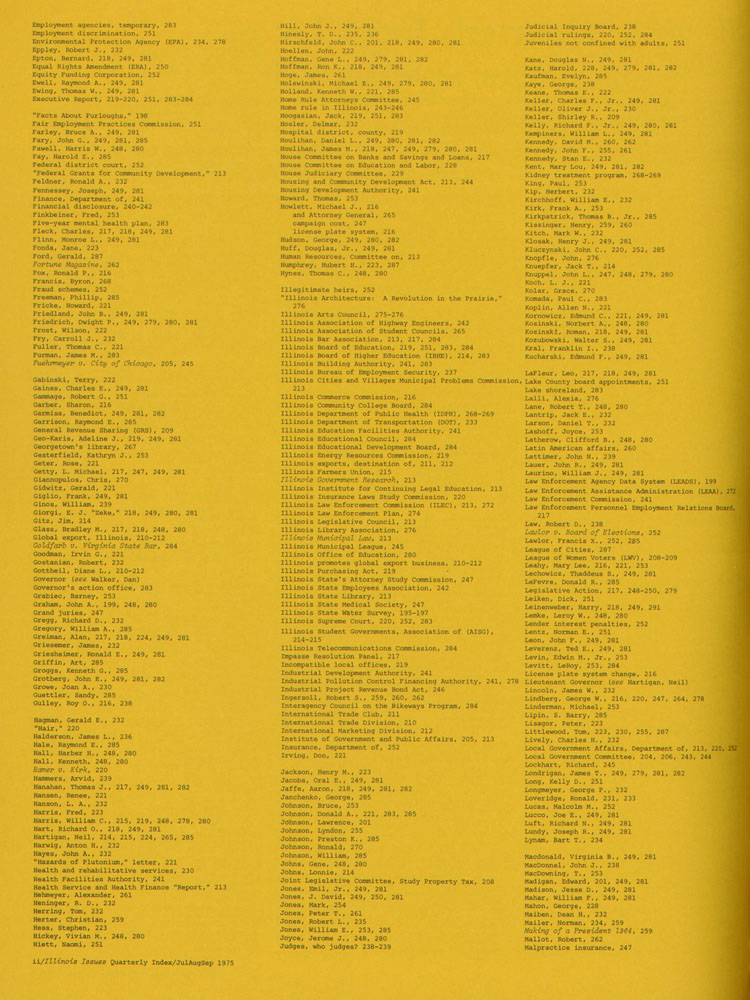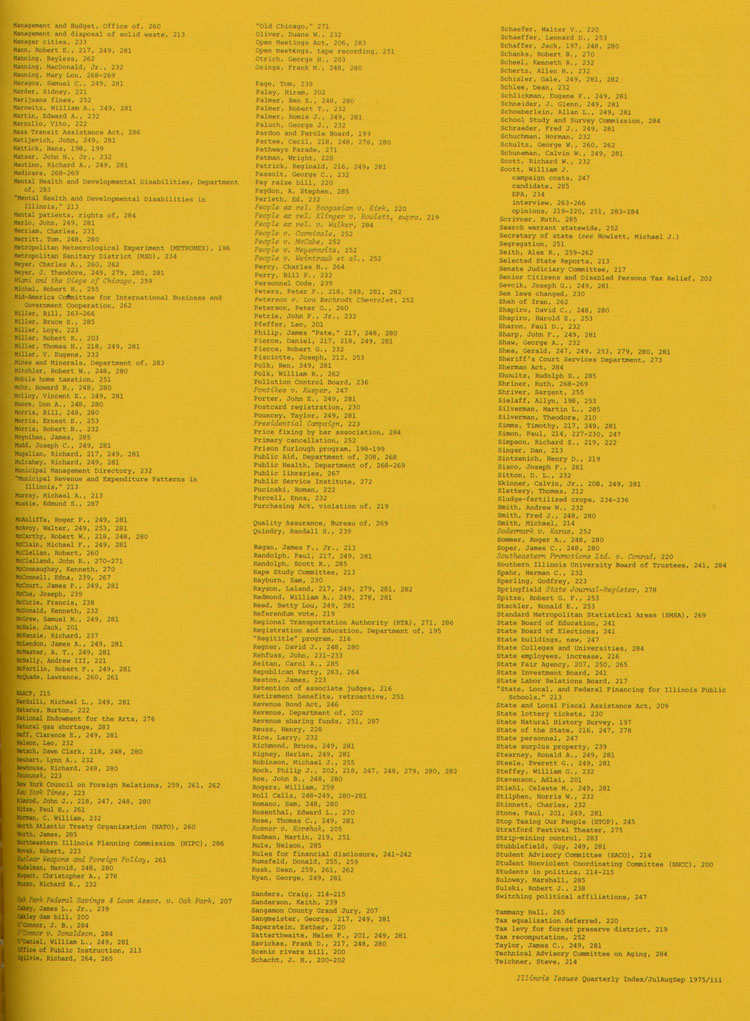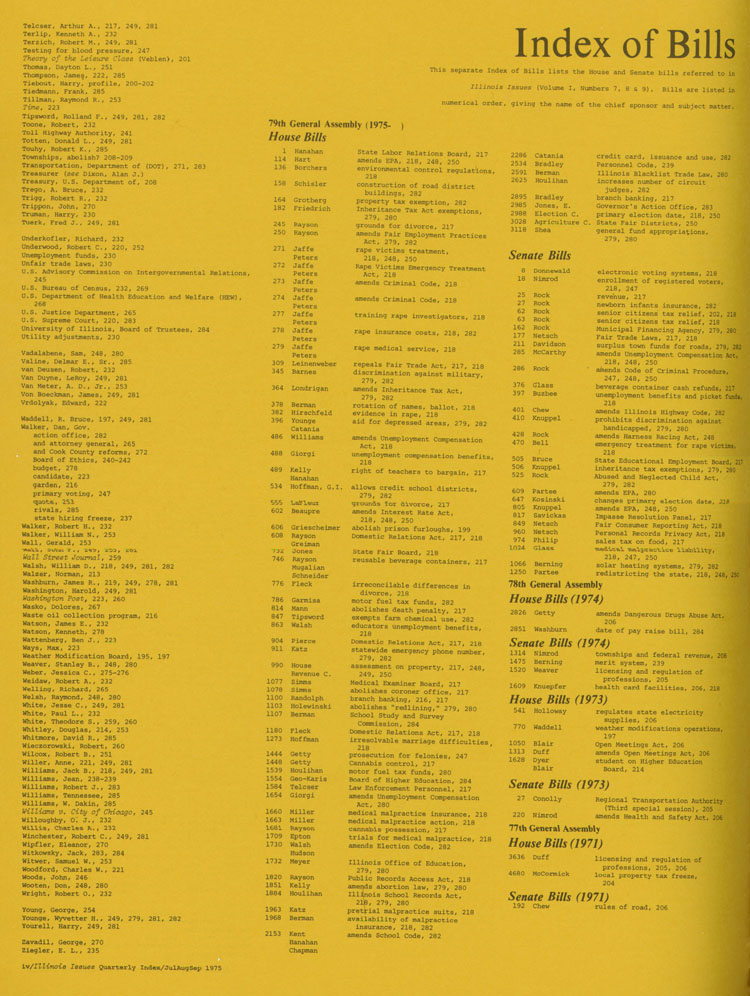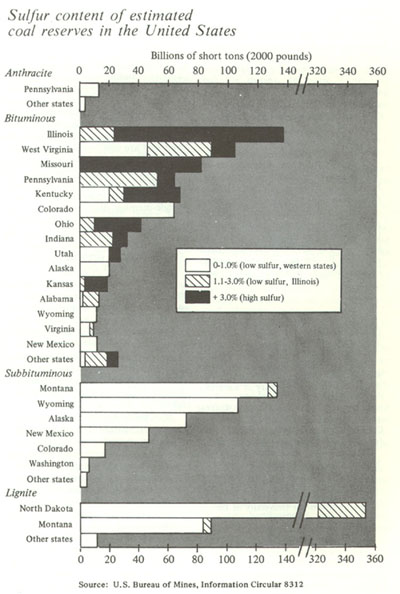
By DONALD S. KLINE Solid black gold: Illinois' coal and America's energy-economy-ecology dilemma ON A CLEAR DAY, if you look
carefully south from the State Capitol in Springfield you can see the twin, 500-foot stacks of the Kincaid power plant
of Commonwealth Edison. The stacks
and the plant are, in many ways, symbols of what The New York Times
called America's "energy-economy-ecology" (EEE) dilemma. A problem of systems But there are problems. U.S. production of crude oil topped out in 1970 and
has been declining since. As energy demand increased during the 1960's, the necessary increase in oil imports gave
the oil exporting nations (OPEC) an
increased share of power in the global
market place. Thus, the 1973 embargo
and the establishment of the oil cartel
has resulted in an historically unprecedented, massive shift of wealth from the
United States, Japan and Western
Europe to the oil exporters. The World
Bank estimates that, at current prices,
the cumulative wealth shift will amount
to hundreds of billions of dollars by
1980. Since this massive outflow could not
be tolerated by our present financial
system, "Project Independence" was
articulated by President Nixon as a
necessary solution. The notion of independence from Mideast oil sources
has been further pursued by President
Ford in his 1975 economic messages. The short-term solution to the high
cost of foreign oil lies in (1) the rapid
development of existing domestic coal
reserves and (2) a stimulus to U.S. offshore explorations for oil and gas. Obviously, the former is of greatest concern for Illinois. Coal in Illinois Coal deposits vary in quality from
high energy anthracite to low energy
lignite with the varieties of bituminous
in between. As the table shows, lower
energy coal (sub-bituminous and
lignite) tends to be located in the states west of the Mississippi and high energy
coal (anthracite and bituminous) in the
states east of the Mississippi. Since
the area of greatest industrial activity
in the United States lies east of the
Mississippi, this situation would appear favorable. But much of the high
energy coal in the East contains high
percentages of sulfur (see the chart on
page 305), and sulfur is just what
federal and state environmental officials say must not be released into the
atmosphere in large quantities. Eastern
industry then needs low sulfur Western
coal, but these industries obviously are
not pleased with the coal's relatively
low energy content, not to speak of the
transportation costs involved. Currently, alternative solutions to
this problem are complicated by two
factors. First, on June 1, 1975, new air
pollution standards went into effect. Second, a strip-mining bill, passed by
Congress for the second time, was
vetoed by President Ford for the second
time. On June 10, 1975, the House of
Representatives failed to override the
President's veto by three votes. Taking into account these two constraints, some of the alternative solutions to the EEE dilemma may be viewed as short-term and temporary.
Low sulfur coal can be imported, at a
high cost, from Montana. High sulfur
Illinois coal can be "washed," to a
degree to remove sulfur, before it is
burned. Stacks can be built, at great expense, to the 800-foot level in order to
dissipate emissions over a wider area.
Other solutions are longer term and
even higher in cost. Gas scrubbers can
be installed. High sulfur coal can be
gasified or liquified at the mine mouth. Illinois coal is high sulfur 302 / Illinois Issues / October 1975
Associate professor of administration at
Sangamon State University, he has degrees
in business. Foreign trade, and social
science. Kline recently taught a course
dealing with the national and global energy
situation.
There is a growing awareness and, indeed, consensus among decisionmakers in both public and private organizations that the reductionist,
fragmented way of viewing the world,
people and problems will not do for the
1980's. In the last four years there has
been a shift in values in our society from
what scholar George Cabot Lodge calls
"scientific specialization and fragmentation" to "a new consciousness of the
interrelatedness of all things." In applying this systems approach, if one takes
the long view of the solution to energy
dilemma of the United States, the inevitable answer is atomic fusion power
and solar power. These are 21st century
solutions. I and many of you reading
this will probably be dead by then. But
how do we cope with energy demands of
the next five or twenty-five years? In the
short run, it appears that we will have to
rely on some uncertain combinations of
oil, gas, and—most important—coal.
In 1973 coal production in the United
States was just under 60 million tons.
Of this, some 380 million tons came
from just four states: Kentucky (127
million tons). West Virginia (115),
Pennsylvania (77) and Illinois (62). But,
future coal production comes from present estimated reserves. The table shows
coal reserves, defined as coal in seams
more than 28 inches thick if located
deeper than 150 feet and in seams more
than 18 inches if located 150 feet deep
or less.
Most of Illinois' vast bituminous
reserves have a high sulfur content. As
noted above, high energy coals seem to
be high sulfur coals and vice versa. The
The short-term solution to the energy crisis may be coal, and Illinois has 140 billion tons in reserve near the nation's industries. But, there is a dilemma. Examine the case of Kincaid power plant and Peabody # 10 mine
energy demands of the country are
often in conflict with its environmental
requirements, but never more so than in
the matter of coal. When the Clean Air
Act of 1972 was partially implemented
in June of this year, high sulfur coal
could still be mined at Peabody Coal
Company's # 10 mine just west of the
Kincaid plant, but could not be burned
at the plant. What can the State of
Illinois and Commonwealth Edison do
about this perplexing situation? Kincaid fossil fuel plant Kincaid, like all fossil fuel plants,
generates large amounts of ash. Bottom
ash is easily and periodically shoveled
out of the boilers. Airborne fly ash is a
different problem. All coal fired units
have installed electrostatic precipitators
which act as giant magnets in attracting ash particles. These devices remove 98 per cent of the fly ash. In newer installations the precipitators are above 99 per cent effective. Coal-burning plants like Kincaid also face the problem of sulfur oxide
emissions. Different grades of coal contain varying amounts of sulfur, as the
chart shows. Some plants have switched
to lower sulfur Western U.S. coal; others have installed gas-stack
"scrubbers." Another similarity of Kincaid and all
fossil plants is their balanced draft
boiler operations. OSHA (Occupational Safety and Health Act)
legislation required these improvements to eliminate gases from the boiler
room. This is an obvious gain in plant
safety. The Kincaid plant is also unique in
several respects. First, Kincaid serves as
a link to other regional U.S. electric
power generating systems within
MAIN (Mid-America Interconnected
Network). The plant was built to and
stands ready to handle excess energy demand from the South and East
(American Electric Power system), the
West (St. Louis system), and from the
North (Commonwealth Edison). Second, Kincaid gets its entire supply
of coal from the Peabody Coal Company # 10 mine located just a few miles
to the west. This mine is the largest in
the world in terms of total tonnage
taken out of one hole. By early 1974,
after 23 years of operation, 100 million
tons of coal had been mined. The
average seam thickness is six feet and
the depth of the mine below ground surface averages 300 feet. The length of the
mine is 12 miles, and a 30-mile continuous conveyor belt allows direct
movement of the coal from the mine to
the Kincaid plant. The recovery rate of
coal at Peabody is 52 per cent (compared with about 75 per cent in the strip
mining operations of the West), but the
remaining coal could be recovered via
coal gasification at the mine mouth.
Within the last six months a "Serpentix" system has been installed to allow
the direct transfer of coal from the mine
The case for or against coal can be
clarified by examining the specific case
of the Kincaid power plant and the
nearby Peabody Coal Company # 10 mine. It is necessary to look at the Kincaid plant in greater detail, both in
terms of its similarities to and
differences from other fossil fuel plants
within the Commonwealth Edison
system. Consider the similarities.
Coal reserves by thirteen leading states by energy category, estimated 1965 (Billion short tons—2,000 pounds)
|
Western |
Anthracite |
Bituminous |
Sub- |
Lignite |
Total |
|
North Dakota |
— |
— |
— |
351 |
351 |
|
Montana |
— |
79 |
132 |
87 |
298 |
|
Wyoming |
— |
13 |
108 |
— |
121 |
|
Alaska |
2 |
21 |
71 |
— |
94 |
|
Colorado |
— |
62 |
18 |
— |
80 |
|
Missouri |
— |
79 |
— |
— |
79 |
|
New Mexico |
— |
11 |
51 |
— |
62 |
|
% of U.S. |
2 13% |
265 36% |
380 98% |
438 98% |
1,085 69% |
|
Eastern |
|
||||
|
Illinois |
— |
140 |
— |
— |
140 |
|
West Virginia |
— |
103 |
— |
— |
103 |
|
Pennsylvania |
12 |
58 |
— |
— |
70 |
|
Kentucky |
— |
66 |
— |
— |
66 |
|
Ohio |
— |
42 |
— |
— |
42 |
|
Indiana |
— |
35 |
— |
— |
35 |
|
% of U.S. |
12 80% |
444 61% |
— —% |
— —% |
456 29% |
|
Thirteen states |
14 |
709 |
380 |
438 |
1,541 |
|
% of U.S. |
93% |
97% |
98 % |
98%, |
98 % |
|
TOTAL U.S. |
15 |
729 |
388 |
448 |
1,580 |
SOURCE: National Air Pollution Control Administration Pub. No., AP-52, 1969.
October 1975 / Illinois Issues / 303
Coal-fired plants will have to meet federal standards on sulfur oxide emissions. Their choice is between importing low sulfur, low energy coal from the West or using Eastern high sulfur, high energy coal, but only after investing in a method to decrease the sulfur
face to the continuous conveyor. Such a
system can now move coal around right
angles within the mine, something not
possible before the "Serpentix" installation. The Kincaid plant uses some four
million tons of high (about 4.2 per cent)
sulfur, bituminous coal a year from the
mine. This unique marriage of Kincaid
and Peabody # 10 provides some insulation against the need to import Western
coal if' (a) Kincaid receives a continuance of its emissions variance
already granted by both federal and
state environmental protection agencies, or (b) a coal gasification process
can be installed. Third, the function of the Kincaid
plant is to "bulk transmit" electricity
out of its own generating area. Other
fossil plants in the Commonwealth
systems were built in the areas they
serve (e.g. the Powerton plant at Pekin).
The Kincaid plant was built in 1967 at a
cost of about $145 million, specifically
to tie into the MAIN system. Because
of this, extra miles of high voltage
transmission lines had to be
erected—345,000 volt lines into the
MAIN network and 765,000 volt lines
feeding into other transmission systems.
Because so many other areas are dependent on Kincaid's power, it illustrates
perfectly Lodge's point about "the interrelatedness of all things." Finally, the Kincaid plant has its own
cooling lake—Lake Sangchris. There are no easy solutions The Kincaid plant is the only fossil
plant in the Commonwealth system
which does not at present "wash" coal
burned to reduce sulfur content. Early
in 1975, the company obtained a
"variance" to operate the Kincaid plant
in the face of new sulfur oxide emission
standards coming into effect in June. By
the spring of 1976, it is planned that all
coal from Peabody # 10 burned at Kincaid will be "washed." This will reduce
the sulfur content by 0.6 to 0.8 of one
per cent—close to the maximum permissible level under the new legislation. Five courses to follow Course of action No. 1 means that,
as, the chart shows, much of Illinois
bituminous coal cannot be burned and
low sulfur coal must be imported at
high cost. People in Illinois get clean
air. What do people in Montana get?
Here is the essential and crucial nature
of a systems approach to the problem.
Strategic decisions must be made which
optimize benefits to society as a whole.
The strip mining of Western coal for the
benefit of Eastern states would have an
unknown but significant impact on the
fragile ecology of the great prairie
states. The second veto of the strip mining bill by President Ford recently—he said we need the coal—may very well'
result in Congress passing an even
stronger bill by a margin that is veto-proof. The great argument was over
how much coal production would be
lost if the bill were passed. No one can
know that. At this time, there are no
plans to import Western coal for burning in the Kincaid plant. At present
rates Peabody can produce coal steadily
until 2070 A.D. Course of action No. 2, "washing,"
as mentioned above, is to be implemented by spring of 1976. It is a solution which is uniquely suited to Kincaid.
Peabody coal will still be shuttled by
conveyor directly from the mine to the
boilers, but it will be washed en route.
However, "washing" coal will take
large amounts of water, water which,
starting in 1980 may be supplied by
Lake Springfield II, presently in the
planning stage. Furthermore, there are
problems of potential water pollution
and solid waste disposal with regard to
the large amounts of toxic substances
which would be "washed" out of the
coal. Course of action No. 3, 800-foot
stacks, may appear to be the best solution, but in reality it only substitutes
one problem for another. Pushing the
sulfur oxide emissions to very high
altitudes by the use of these tall stacks
merely removes the pollutants from one
small geographic area (Springfield) to
another (depending upon prevailing
winds—Eastern Illinois, Indiana,
Northern Kentucky). This course of action may permit the burning of Peabody
high sulfur coal and therefore aid the
economy of the state by providing
energy. This is the benefit, but the
systems approach to the EEE dilemma
requires that the cost to other parts of
the system be considered as well as the
costs to society as a whole. A few years
ago, when Apollo astronauts flew over
the United States they commented that
large parts of the entire Colorado
plateau were hidden not by nature's
clouds but by man's smog. One explanation for the smog was the burning
of coal in huge thermal generating
plants in the Four Corners section of
the Southwest to furnish electricity to
the Los Angeles basin. Los Angeles had
earlier decided that it did not want the
pollutants in its air. In the finite system
of our planet—referred to as Spaceship
Earth—one of the basic laws of ecology
is that "everything has to go somewhere." 304 / Illinois Issues / October 1975
The federal EPA has established
desired air standards for sulfur oxide
emissions at two levels: (1) primary
standards to protect public health at .03
parts per sulfur oxide for one million
parts of air: and (2) secondary standards to protect public welfare at .02
parts of sulfur oxide per one million
parts air. The "health" standard of .03 parts per million went into effect on
June 1, 1975. This controls 90 per cent
of all sulfur oxide emissions.
Given the new federal emission standards, there are basically five courses of
action for coal-fired plants: (1) burn low
sulfur (less than 1 per cent content); import low energy coal from the Western
states; (2) "wash" Illinois high sulfur
coal to reduce sulfur content; (3) go to
intermittent control systems of tall
(over 800-foot) stacks; (4) rapidly install costly gas "scrubbers"; (5) remove
sulfur by a "front-end" process of coal
gasification or liquefaction (conversion
to low sulfur oil).




Course of action No. 4. the "gas scrubber, "is currently a source of great controversy. The federal EPA has slated that "gas scrubbers" are the "most immediately promising control system for sulfur dioxide." The issue is, like most today, technically complex. First, chemicals such as calcium sulfate and calcium sulfite are formed in the scrubbing or washing process. These "outputs" of the process plug spray nozzles and valves and every few days must be removed by high pressure hoses or even a man with a hammer. In some extreme cases plant shutdowns are required. Second, sludge byproducts must be disposed of. This sludge contains high concentrations of sulfur and there is a strong probability that it will seep from the disposal beds into underlying water tables. Also, shipping sludge from urban areas is quite costly. Thus, air pollution could be—given unknown lag times—converted into dangerous water pollution. The question of the gas scrubber also arose in a controversy between City Water Light and Power (CWLP) in Springfield and the Illinois EPA over the construction of the Dallman III fossil fuel plant. One difference between CWLP and Commonwealth Edison is that, by Illinois law. publicly owned utilities like CWLP can burn only Illinois coal.
|
Still other problems Course of action No. 5, gasification or liquefaction, appears to be no better and may even be far worse depending on what kind of coal or lignite is gasified or liquified at which location. One obvious possibility is to gasify the subbituminous and lignite at the mine mouth in Montana and Wyoming. Two ecological problems emerge. The first is the devastation to the fragile lands mentioned earlier. Secondly, massive amounts of water are required for the gasification or liquefaction process. The water needed for a network of, say 50 of these plants, would very rapidly begin to compete with the agricultural water needs of the vast Western wheatlands. Further, as the water is circulated through the degasification system it too has to be purified or else it will rapidly contribute to water pollution in those lands. On the other hand if the "frontend" gasification of liquefacfion process were to take place in Illinois, the water requirements could be more easily met. There are many other problems surrounding the FEE dilemma not the least of which is capital financing. In February 1975, Commonwealth Edison announced cancellation of plans to build coal gasification facilities at both the Powerton (Pekin) and Kincaid stations. To attach gasification systems to the four generating stations at the two sites would cost $1.7 billion—three limes the estimated cost of a year earlier. Said James Fancher, director of air quality for Commonwealth Edison, "We still believe large scale coal gasification will prove to be technically and economically feasible if time is allowed for its orderly development. But it is clear that installing such systems on a crash basis during early stages of the technology would not be prudent." Mr. F.E. "Bud" Stauffer, superintendent of the Kincaid station, concurred, saying, "Gasifiers are not far enough along to process soft coal—a lot has to be learned." |

|
October 1975 / Illinois Issues / 305